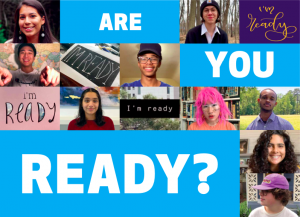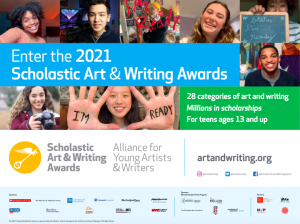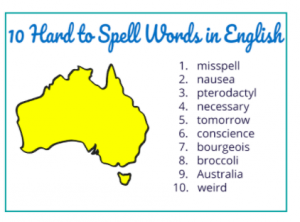All posts by lspady
Scholastic Art & Writing Awards


Who: Teens in grades 7-12 (ages 13 and up) can apply in 28 categories of art and writing
What: The nation’s longest-running, most prestigious recognition program for creative teens.
When: Writing Deadline: December 15 and Art Deadline: December 18
Find out more at https://www.artandwriting.org/awards/
If you need help submitting your work, email Dr. Spady at spady.lynn at westside66.net
2020-21 Weekly Challenge #13: Word Art

Week of November 16-20
For this week’s Weekly Challenge, you will be creating a piece of word art using the following website: https://wordart.com/
Some ideas for your Word Art:
- Type your name and your family members/friends’ names
- Type the things you are thankful for
- Type your favorites (food, music, color, artist, subject, etc.)
- Type in the names of your favorite books/characters
- Type in words associated with your favorite seasons
Suggestion…Create several different pieces of word art using the website and experiment with different shapes, fonts, colors, etc. After you’ve created a few, submit your favorite creation using this link: https://forms.gle/sJ3yKxaTVeYqQYvBA
#45: Science Buddies Contest
 K-12 students worldwide are invited to give engineering a try with the annual Engineering Challenge from Science Buddies. Announced every January, the Science Buddies Engineering Challenge lets students use their problem-solving skills to design, build, and test contraptions. The challenges use simple materials and are free for all to participate.
K-12 students worldwide are invited to give engineering a try with the annual Engineering Challenge from Science Buddies. Announced every January, the Science Buddies Engineering Challenge lets students use their problem-solving skills to design, build, and test contraptions. The challenges use simple materials and are free for all to participate.
Spark your learning!
1. Set up your STEAM mini spark recording page: #45:Science Buddies Contest
2. Each challenge that science buddies has prepared for you has an introduction video that show the challenge and what you will build. Look at the list below and choose 6 that sound interesting. Add those to your recording sheet.
- 2025 Engineering Challenge-Opens in Jan 2025
- 2024 Rubber Band Car Challenge
- 2023 Ping Pong Pickup Challenge
- 2022 Ball Run Challenge
- 2021 Tallest Tower Challenge
- 2020 Cricket Wicket Knockdown Challenge
- 2019 Volleyball Machine Challenge
- 2018 Ball Launcher Challenge
- 2017 Follow the Flow Challenge
- 2016 Marble Machine Challenge
- 2015 Balloon-Powered Car Challenge
3. Watch each of the videos you picked. For each one, record the name of the challenge, the materials needed, and summarize the project in one sentence.
4. Share your STEAM mini spark recording page with your teacher/EY coordinator.
Check out the Engineering Design Challenge badge at the EY Website if you want build one of the challenges.

Check out the STEAM mini spark #25 to learn about the engineering design process.

#54: What’s Cooking
 This mini spark has you wring all about cooking up something in the kitchen!
This mini spark has you wring all about cooking up something in the kitchen!
Spark your thinking!
1. Set up your language arts mini spark recording page: #54: What’s Cooking
2. Learn how to write a recipe. Watch this video to show you the steps. Take simple notes on your recording page about the procedural text steps.
3. Learn how to write a recipe like a professional. Read this article which outlines the process. This is very detailed, but has some really good pointers. On your recording page, write about how this article is helpful. Include a question you have about writing recipes as well.
4. Ask a grandparent, relative, parent(s), teacher, etc. for a recipe idea. Add a picture of the recipe to your recording sheet
5. Using the recipe that you have been given, create a more formal version using the information from the video and the article. The recipe should be typed and please include all of the procedural text steps.
OPTIONAL: Make something in the kitchen and take a picture/video of the process and/or final product. Make sure your creation has a name and that you provide the ingredients necessary to make your recipe. Make sure to get an adult’s approval first before you start.
6. Share your language arts mini spark recording page, starting recipe, and final recipe with your teacher/EY coordinator.
#44: Tangram Art

Spark your math thinking!
- Set up your STEAM mini spark recording page: 44: Tangram Art
- Watch this intro video. Write the tangram rules and puzzle shapes on your recording page.
3. Try out this a tangram puzzle site with challenges to stretch your thinking.
4. Choose 2 puzzles to solve. Add a picture of your finished puzzles to your recording sheet.
5. Make Tangram art! Choose a tangram animal or shape that you would like to use for an art piece.
6. Supplies needed: Ask your EY teacher for a plastic tangrams set, your choice of crayons, markers, watercolors, or colored pencils, and paper.
7. Watch the teaching video.
8. Share your math mini spark recording page and your art piece with your teacher/EY coordinator.
Check out the Tangram Badge at the EY website. 
#43: Mini Stop Motion
 stop-mo·tion noun-a cinematographic technique whereby the camera is repeatedly stopped and started, for example to give animated figures the impression of movement.
stop-mo·tion noun-a cinematographic technique whereby the camera is repeatedly stopped and started, for example to give animated figures the impression of movement.
Spark your thinking!
1. Set up your STEAM mini spark recording page: #43: Mini Stop Motion
2. Watch this video to get started. On your recording sheet respond to these prompts.
- What are some techniques used to create facial expressions in puppets
- How has the introduction of 3D printing influenced the production of stop-motion animation?
4. Record your idea for a tiny story, what materials you would use for your stop motion and your set.
5. Collect a few materials, add stop motion studio to your ipad, and create a tiny stop motion.
6. Share your STEAM mini spark recording page and your stop motion with your teacher/EY coordinator.
Check out the Stop Motion Animation Badge on the EY website.

#42: New Inventions
 What inventions need to be invented? How about a bed-Making Machine: A fun machine that automatically makes your bed for you! Maybe a Spaghetti Twirling Fork: A rotating fork that helps you twirl spaghetti perfectly for a delicious meal. In this mini spark you will learn about some new inventions that were launched in 2023.
What inventions need to be invented? How about a bed-Making Machine: A fun machine that automatically makes your bed for you! Maybe a Spaghetti Twirling Fork: A rotating fork that helps you twirl spaghetti perfectly for a delicious meal. In this mini spark you will learn about some new inventions that were launched in 2023.
Spark your thinking!
1. Set up your STEAM mini spark recording page: #42: New Inventions
2. Every year, TIME magazine puts out its list of the year’s best inventions. Some of these help us solve problems. Others make life easier, or more fun. TIME for Kids features 10 of them here.
3. Go to the TIME for Kids webpage dedicated to the best inventions on 2023.
4. Number your recording page from 1-10. Write the name of each invention showcased in the post and a 5 word summary.
5. At the bottom on the page explain which one of the inventions you think is the best?
6. Share your STEAM mini spark recording page with your teacher/EY coordinator.
#53: Amanda Gorman

Amanda Gorman is an L.A. native poet and humanitarian activist. Through her works, she tries to talk about oppression from the police, racism, discrimination, and women’s rights. She graduated from Harvard University in 2020 with a cum-laude status and was named the youngest poet ever to read an inauguration poem in U.S. history.
Spark your thinking!
1. Set up your Language Arts Mini Spark recording page: #53: Amanda Gorman
2. Watch Amanda Gorman read her poem “Talking Gets Us There”. Choose one of these question sets to thoughtfully answer on your recording page.
- Social Justice: Where do we see examples of racism? Where do we see examples of people who have “talked about it?”
- Poetry: How does Amanda Gorman use rhythm to keep readers/listeners engaged? What lines stand out and why?
- Art: How does the art/video enhance the meaning of the poem? What changes would you make to the art if you had the chance.
3. Watch this video. On your recording sheet list 5 ways that Ms. Gorman changed America.
4. Read this interview. Choose one of the Q and A and write about your reaction.
5. Write a rhyming poem about one of these topics: yourself, Amanda Gorman, poems, or promoting change. Use this rhyming dictionary if you would like.
6. Share your Language Arts Mini Spark recording page with your teacher or EY Coordinator.
#78 If I had a million…

Spark your math thinking!
- Set up your math mini spark recording page: #78 If I had a million…
- For inspiration, listen to How Much Is A Million by David M. Schwartz.
3. Explore the length of ONE MILLION objects. You have two options for your recording sheet: you can either print a copy or fill out a digital version. You can also make the charts on your recording page.
4. Create a visual to display your information. You can use an app of your choice on your iPad or computer. You can also draw/color on paper.
5. Share your math mini spark recording page and ONE MILLION object page with your teacher/EY coordinator.
